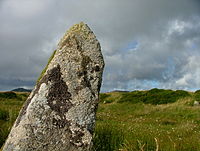King Arthur's Hall: Difference between revisions
m clean up, replaced: medieval → mediæval (2) |
|||
| (One intermediate revision by one other user not shown) | |||
| Line 12: | Line 12: | ||
==Origin and use== | ==Origin and use== | ||
In the absence of any archaeological finds, its origin and use is only speculative.<ref name=pastscape>{{pastscape|433143|King Arthurs Hall}}</ref> A similar enclosure exists in Brittany which was a Bronze Age cremation site, but a similar rampart construction at [[Lough Gur]] in [[Ireland]] suggests an earlier, Neolithic date.<ref name=pastscape/> It has even been suggested that it was merely a | In the absence of any archaeological finds, its origin and use is only speculative.<ref name=pastscape>{{pastscape|433143|King Arthurs Hall}}</ref> A similar enclosure exists in Brittany which was a Bronze Age cremation site, but a similar rampart construction at [[Lough Gur]] in [[Ireland]] suggests an earlier, Neolithic date.<ref name=pastscape/> It has even been suggested that it was merely a mediæval cattle pound, but the effort required to build the bank and to erect the slabs suggests that it had a more important function.<ref name=pastscape/> | ||
Some clearance and investigation of King Arthur's Hall was conducted by members of The Heritage Trust in 2013/14.<ref name=pastscape/> Their work revealed a revetment wall built to retain the inner bank.<ref name=pastscape/> It was concluded that over time the earth had covered over the top of the revetment wall and that around 140 upright stones now lie buried, recumbent, or standing at an angle.<ref name=pastscape/> It was suggested that the structure originally formed a tank which filled with water, possibly for ritualistic use.<ref name=pastscape/> | Some clearance and investigation of King Arthur's Hall was conducted by members of The Heritage Trust in 2013/14.<ref name=pastscape/> Their work revealed a revetment wall built to retain the inner bank.<ref name=pastscape/> It was concluded that over time the earth had covered over the top of the revetment wall and that around 140 upright stones now lie buried, recumbent, or standing at an angle.<ref name=pastscape/> It was suggested that the structure originally formed a tank which filled with water, possibly for ritualistic use.<ref name=pastscape/> | ||
| Line 21: | Line 21: | ||
==Outside links== | ==Outside links== | ||
{{Commons}} | {{Commons}} | ||
*[http://www.megalithic.co.uk/article.php?lat=50.57195&lon=-4.6483 King Arthur's Hall photographs] - The Megalithic Portal | |||
==References== | ==References== | ||
Latest revision as of 10:49, 30 January 2021

King Arthur's Hall is a megalithic enclosure on Bodmin Moor in Cornwall. It is thought to be a late Neolithic or early Bronze Age site
Description

The monument consists of fifty-six stones arranged in a rectangle with a bank of earth around them and measures approximately 20 yards by 50 yards. The interior fills with water and a contemporary ground level has not been established.[1]
It has suffered damage by cattle in the past and is now protected by a gated fence. It can be reached by footpaths east of St Breward.
The surrounding area contains many stone circles, hut circles, cairns and cists.
Origin and use
In the absence of any archaeological finds, its origin and use is only speculative.[2] A similar enclosure exists in Brittany which was a Bronze Age cremation site, but a similar rampart construction at Lough Gur in Ireland suggests an earlier, Neolithic date.[2] It has even been suggested that it was merely a mediæval cattle pound, but the effort required to build the bank and to erect the slabs suggests that it had a more important function.[2]
Some clearance and investigation of King Arthur's Hall was conducted by members of The Heritage Trust in 2013/14.[2] Their work revealed a revetment wall built to retain the inner bank.[2] It was concluded that over time the earth had covered over the top of the revetment wall and that around 140 upright stones now lie buried, recumbent, or standing at an angle.[2] It was suggested that the structure originally formed a tank which filled with water, possibly for ritualistic use.[2]

Outside links
| ("Wikimedia Commons" has material about King Arthur's Hall) |
- King Arthur's Hall photographs - The Megalithic Portal
References
- ↑ Access to Monuments - King Arthur's Hall
- ↑ 2.0 2.1 2.2 2.3 2.4 2.5 2.6 National Monuments Record: No. 433143 – King Arthurs Hall
